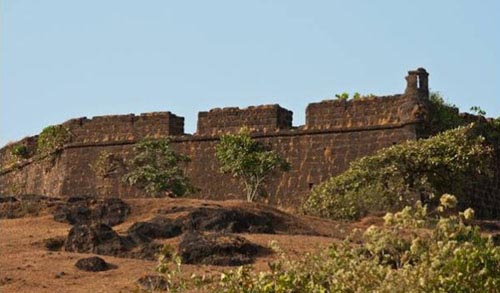Chapora Fort

Information on Chapora Fort (Goa) - History & Architecture
The Chapora Fort is located in the Bardez area of Goa near to the river banks of Chapora River. However, prior to the rule of the Portuguese, this site in which the fort is located was the located another fort during the period of 15th century.
Chapora Fort Architecture
The fort is primarily made following the Portuguese style of architecture. The fort is mainly popular for its natural beauty owing to presence of a large number of coconut and palm trees. Though very less part of the fort is preserved, some existed clearly presents its architectural heritage. After the restructure of the fort under the Maratha rulers, some parts of the monuments depict the Muslim architectural style. Within the fort there are secret tunnel made by the Portuguese rulers in 1717 which were used as emergency path to escape during battle. The location in which the fort was built is quite prominent owing to the aspect that it can provide a commanding view of all the directions around. In each of its side, the fort has steep slopes which were made to deal with the intruders. Furthermore, the irregular outside wall of the fort which are high in terms of height acts as an element of defence during the time of battle. The main entrance of the monument is quite small and plain which restricts the entry of too many people at one time. There are also specific positions within the fort which were used by the Portuguese rulers to position their cannon and bastions.
Chapora Fort History
The monument was recorded in the history books to have built during the year 1510. During this particular period, the place i.e. Goa was under the rule or influence of the Portuguese rulers. The structure of the fort has witnessed several transformations after the Portuguese intruders acquired the Bardez region. Notably, history suggest that with the intention to end the rule of the Portuguese in Goa, famous king Akbar join hands with the enemies of his family i.e. Marathas during the late 16th century. Post this incident Akbar made his base camp in Goa with the help of the Maratha rulers. This further led to the battle where the Portuguese rulers succeeded in pining down the Marathas. However, with regard to their understanding about the potential future risks, the Portuguese rulers have strengthened their defence in the northern part to deal with the enemies coming from that end. The fort which can be seen in the present day context was redesigned and rebuilt in the year 1717. After the Portuguese left the fort, the Marathas held it for some time in 1739. Later the fort was overtaken by Pernem and Sawantwadi who were the Hindu rulers in Goa during that period.
Chapora Fort Tourism Importance
The fort can add a better experience for the tourists who visit Goa from all over the country and the world. Though most parts of the fort is ruined, it still certain parts that showcases the prominence of the fusion of Muslim and Portuguese architecture. Again, it has also been noted that the views one can get of the beaches and seas of Goa from the fort acts as an amazing experience for the visitors. Moreover, in an around the fort there are numerous restaurants which can ensure a convenient visit in the fort for the visitors. Direct buses and private vehicles are available from the capital of the state to reach the fort.
- Andaman Nicobar Monuments
- Andhra Pradesh Monuments
- Assam Monuments
- Bihar Monuments
- Chhattisgarh Monuments
- New Delhi Monuments
- Goa Monuments
- Gujarat Monuments
- Haryana Monuments
- Himachal Pradesh Monuments
- Jammu and Kashmir Monuments
- Karnataka Monuments
- Kerala Monuments
- Madhya Pradesh Monuments
- Maharashtra Monuments
- Odisha Monuments
- Punjab Monuments
- Rajasthan Monuments
- Tamil Nadu Monuments
- Telangana Monuments
- Uttar Pradesh Monuments
- West Bengal Monuments